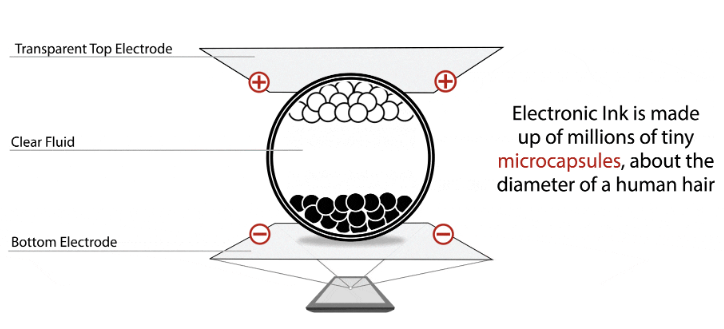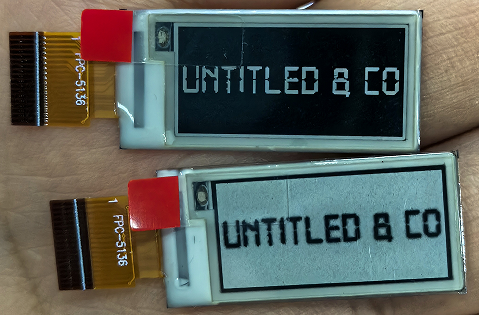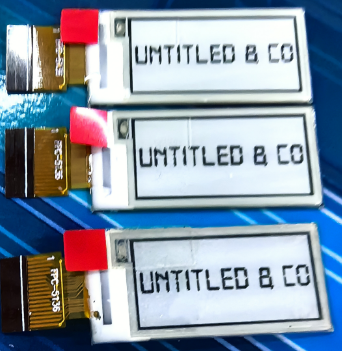1. Electronic ink application principle
Since electronic ink is a liquid material, it is figuratively called electronic ink "water". In this liquid material, there are hundreds of microcapsules about the same size as the diameter of a human hair suspended, each of which is composed of positively charged particles and negatively charged particles. As long as a certain process is adopted, this electronic ink can be printed on the surface of glass, fiber or even paper media. Of course, these carriers that carry electronic ink also need to be specially processed, and a simple pixel control circuit is constructed for each pixel in it, so that the electronic ink can display the images and texts we need.
When a negative electric field is applied to both ends of the microcapsule, the white particles with positive charge move to the negative pole of the electric field under the action of the electric field. At the same time, the particles with negative charge move to the bottom of the microcapsule and "hide", and the surface will appear white. When a positive electric field is applied to both sides of the adjacent microcapsules, the black particles will move to the top of the microcapsule under the action of the electric field, and the surface will appear black. Therefore, electronic ink technology can make any surface a display screen. As shown in the figure below

2. Readability
If electronic ink only has the characteristic of display, it is far from enough. For an electronic display device that hopes to replace paper media, it must be readable and portable.
LCD and CRT displays have a much lower resolution than paper, and long-term use can easily make people tired. Therefore, in terms of information readability, electromagnetic display devices cannot replace the position of paper media at all. The two factors that determine the readability of display devices are display brightness and contrast. Display brightness is the luminous flux transmitted from the display surface to the observer's eyes. For divergent display devices, brightness depends on the light generated, while the brightness of reflective display devices depends on the surrounding lighting conditions and the reflectivity of the display device itself, among which the reflectivity of the product is the most critical. Contrast is the ratio of the white brightness of the screen to the black brightness, which is one of the reasons why our eyes can distinguish different surfaces. To improve the readability of display devices, sufficient brightness and good contrast are necessary.
Divergent display devices can emit light by themselves, so they can be used normally even in dim light conditions. However, as the intensity of ambient light increases, the display effect of this display is less satisfactory, because strong ambient light increases the brightness of melanin and reduces contrast, which is why we cannot see the text on the display clearly under direct sunlight. Reflective displays display images by reflecting ambient light. The brightness of the image will change according to the intensity of the ambient light, and the eye contrast will also change accordingly, so the advantages of reflective displays are more obvious under strong light.
In actual applications, the range of ambient light is quite large, ranging from 100 lux (dim indoor light conditions), 1000 lux (moderate light in the office) to 50,000 lux (direct sunlight conditions). In order for a divergent display to maintain readability over such a wide range, the backlight source must be adjusted to be strong enough. Even a laptop computer display powered by a lithium battery cannot work under such a wide range of ambient light, which puts more stringent requirements on the battery. The final result will definitely increase the cost of the equipment and greatly reduce the portability of the equipment. This shows that reflective displays are indeed more suitable for use in portable devices.
3.Technological advantages
1) Light and thin
Electronic ink display devices are usually very thin and light, but their structure is more durable than ordinary LCDs. Traditional LCD devices are limited by structural limitations, so their thickness cannot be too thin (if the thickness of the two layers of glass of the LCD screen is 0.7mm, and the thickness of the two layers of substrates is 0.5mm, then the thickness of the LCD screen will not be less than 2mm), and their weight cannot be too light. The hardware structure of electronic ink display devices is quite simple, and its thickness can be about 1mm, and the thickness of the display screen is less than half of that of LCD. In addition, the scope of application of electronic ink is quite wide. It can be used not only on glass surfaces, but also on plastic and other material surfaces, so it is not as fragile as LCD screens.


2) Low power consumption
Electronic ink consumes very little power and can display a picture even when the power supply is temporarily cut off. The reason for its very low power consumption is that its reflectivity and contrast are very high, and there is no need to use a backlight to improve readability.
3) Simple process
Electronic ink display devices can use the same AMLCD production equipment, and the production process is simpler. Simply apply the electronic ink to the ITO plastic substrate, and then attach it to the TFT backplane using the laminator process. This process is the same as the polarizing film attachment method in the ICD production process, and this process can be produced using existing equipment or similar equipment. The simplification of the production process means an increase in yield and output, and the reduction in substrate thickness also significantly reduces costs.
Electronic ink is the only electronic paper technology that can be promoted and applied in the market. In addition to electronic ink technology, there is also color electronic paper, but the technology of color electronic paper is still under development.
For more information about e-paper, please contact us directly.







 Search
Search





